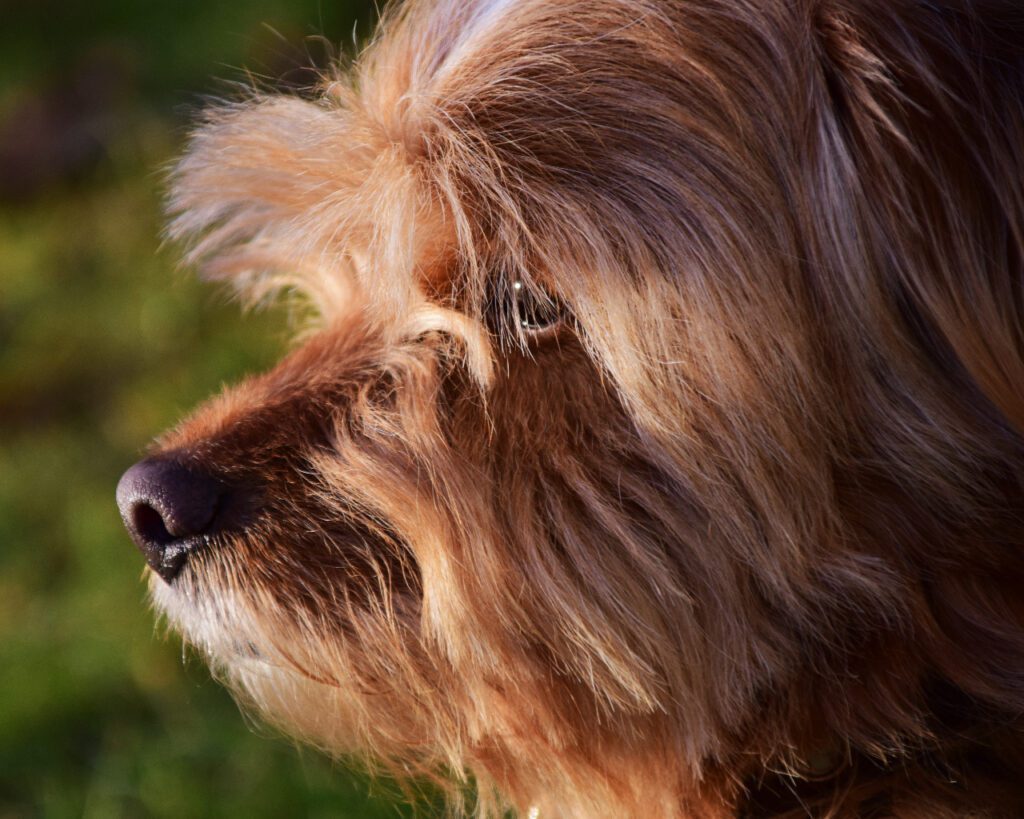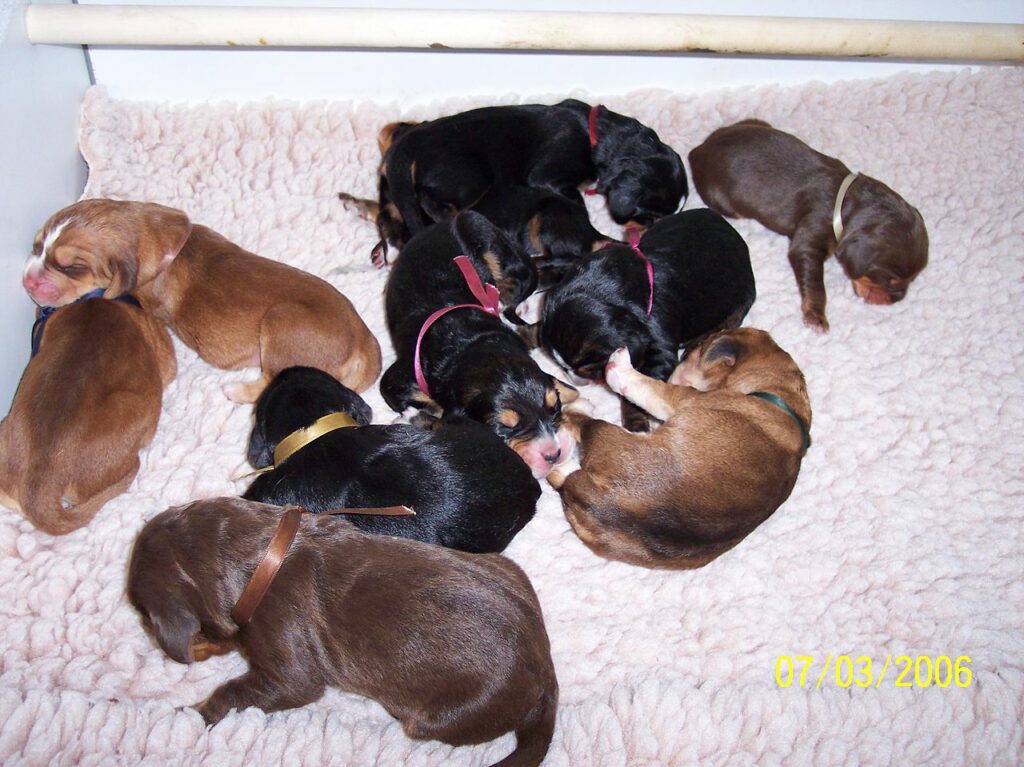Are you considering breeding Otterhounds or are simply curious about this rare breed’s reproductive capabilities?
Then you might be wondering how many puppies an Otterhound can have.
While the answer to this question can vary depending on several factors, such as the dog’s health, age, and genetics, there are some general guidelines to keep in mind.
In this blog post, we’ll explore the average litter size of Otterhounds and what you need to know if you plan on breeding these lovable dogs.
Key Takeaway
- An Otterhound can have a litter of anywhere from 2 to 13 puppies, with an average litter size of 6 puppies.
- Breeding should only be undertaken with careful consideration and planning under the guidance of a trusted veterinarian or animal expert.
- Proper prenatal care, nutrition, and medical attention throughout the pregnancy and beyond are essential for the health and well-being of both mother and puppies.
- Large litters can pose potential risks such as inadequate nutrition, dehydration, increased stress levels, over-exertion of the mother’s body, and disease transmission.
- The age of the Otterhound is a significant factor in determining the number of puppies in a litter. Generally, dogs between two and five years old tend to have larger litter sizes.
- Otterhounds are a high-energy breed that requires regular exercise to keep them happy and healthy. They have webbed feet and love to swim.
- Otterhounds are generally friendly and affectionate dogs that make good family pets. They have a strong maternal instinct and typically take excellent care of their young.
- Proper feeding and exercise routines, regular check-ups with a veterinarian, and a comfortable environment are essential to ensure the health and well-being of pregnant Otterhounds.
- How Many Puppies Can an Otterhound Have?
- What is The Smallest and Largest Litter Size Ever Recorded For an Otterhound?
- Can Otterhounds Have Large Litters Compared To Other Dog Breeds?
- Are There Any Factors That Can Influence The Number of Puppies an Otterhound Can Have?
- Is The Litter Size of Otterhounds Consistent Across Different Breeding Pairs?
- Are There Any Risks Associated With Large Litters in Otterhounds?
- How Does The Age of The Otterhound Affect The Number of Puppies in a Litter?
- Caring For A Pregnant Otterhound
- FAQs
- Q: What is an otterhound?
- Q: How many puppies can an otterhound have?
- Q: What is the temperament of an otterhound?
- Q: Where can I find otterhound breed information?
- Q: Are otterhounds a rare breed?
- Q: Do otterhounds have webbed feet?
- Q: What should I feed my otterhound?
- Q: Are otterhounds good with children?
- Q: Are otterhounds considered a high-energy dog?
- Q: Can otterhounds be used for dog sports?
- In Conclusion
How Many Puppies Can an Otterhound Have?

An Otterhound can have a litter of anywhere from two to twelve puppies, although litters of six or seven puppies are more common. The average litter size for an Otterhound is six puppies.
It’s important to keep in mind that breeding should only be undertaken with careful consideration and planning, and with the guidance of a trusted veterinarian or animal expert.
While Otterhounds are a relatively healthy breed overall, they may be prone to certain genetic health risks that could affect the health of their offspring.
To ensure the health and well-being of both mother and puppies, it’s essential to provide proper prenatal care, nutrition, and medical attention throughout the pregnancy and beyond.
What is The Smallest and Largest Litter Size Ever Recorded For an Otterhound?

The smallest litter size ever recorded for an Otterhound is one pup, while the largest litter size ever recorded is thirteen pups.
This breed typically has an average litter size of five to eight pups. However, due to its large size and muscular frame, it can be difficult for a female Otterhound to give birth to a larger number of pups at once.
The mother’s health must also be taken into consideration when determining if a larger litter is possible or not.
With good nutrition and care, however, a female Otterhound can have litters with more puppies than average.
It is important that only experienced owners attempt to breed this breed as they require careful handling during the birthing process.
Can Otterhounds Have Large Litters Compared To Other Dog Breeds?
Yes, Otterhounds can have larger litter compared to other dog breeds. On average, an Otterhound litter consists of 6-12 puppies, whereas the average litter size for most other breeds is only 5-6 puppies.
Additionally, as gun dogs and scent hounds, Otterhounds are known for their strong maternal instincts and typically take excellent care of their young.
Therefore, it’s not uncommon for them to reach the upper limit of their litter size potential.
Are There Any Factors That Can Influence The Number of Puppies an Otterhound Can Have?
Yes, several factors such as the size and health of the mother, and her age can influence the number of puppies an Otterhound can have.
A larger and healthier female may be able to produce more puppies than a smaller or weaker one. Additionally, younger dogs tend to have larger litters than older ones.
Finally, some breeds are known for having larger litters than others. All these factors can affect the number of puppies an Otterhound can have in any given litter.
Is The Litter Size of Otterhounds Consistent Across Different Breeding Pairs?
The litter size of Otterhounds is not typically consistent across different breeding pairs. It can vary depending on various factors, such as the age of the parents, their overall health and nutrition, as well as heredity.
On average, an Otterhound litter usually consists of five to six puppies. However, it is not uncommon for a litter to have fewer or more than this number.
In addition, due to the wide variety of genetic traits among Otterhounds from different lines and even within those same lines, litter sizes may differ significantly between two otherwise similar litters from different pairings.
The best way to ensure good litter size consistency is to find an experienced breeder with healthy parent dogs that have been properly screened for genetic issues.
This will help to ensure a healthy litter with puppies of consistent size and quality.
Are There Any Risks Associated With Large Litters in Otterhounds?
Yes, there are potential risks associated with large litters in Otterhounds such as inadequate nutrition, dehydration, increased stress levels, and over-exertion of the mother’s body.
Large litters can be difficult for a mother to care for and manage.
Additionally, overcrowding can lead to an increase in disease transmission among puppies due to poor hygiene practices and lack of ventilation.
Finally, large litters may require more veterinary attention than smaller ones since they tend to have higher rates of health problems.
To minimize these risks it is important for breeders to carefully monitor their females during pregnancy and take appropriate precautions when delivering the litter.
Additionally, owners should ensure that their puppies receive proper vaccinations and regular check-ups to keep them healthy and happy.
How Does The Age of The Otterhound Affect The Number of Puppies in a Litter?
The age of the Otterhound is a major factor in determining the number of puppies in a litter. Generally, if a female is under two years old or over eight years old, she is unlikely to have a large litter.
If she is between two and five years old, her litter can range from as few as one pup to as many as twelve pups. The average litter size for Otterhounds ranges from four to seven pups.
Studies suggest that most females will produce fewer than six pups per litter after the age of six. As an Otterhound ages, its fertility decreases and owners should expect smaller litters when breeding older dogs.
Caring For A Pregnant Otterhound
Here is a step-by-step guide on caring for a pregnant Otterhound:
Step 1: Visit a Vet
Schedule an appointment with your veterinarian as soon as you suspect that your Otterhound may be pregnant. A veterinarian can confirm the pregnancy, estimate the due date, and advise you on the proper care and nutrition for both the mother and her puppies.
Step 2: Provide Adequate Nutrition
A pregnant Otterhound requires a well-balanced diet to support healthy fetal growth and development. Feed her high-quality puppy food, which is high in protein, fat, and calories. Divide her meals into smaller, more frequent portions throughout the day to prevent digestive upset and ensure adequate nutrient absorption.
Step 3: Exercise
Maintain a regular exercise routine for your Otterhound throughout her pregnancy, but avoid strenuous activities or rough play. Short walks and gentle exercises are recommended to keep her muscles toned and promote blood circulation.
Step 4: Create a Comfortable Environment
Create a comfortable and secure environment for your Otterhound to relax in during her pregnancy. Provide a clean, dry, and warm area for her to rest. Make sure she has access to plenty of fresh water.
Step 5: Regular Check-ups
Schedule regular check-ups with your veterinarian throughout the pregnancy to monitor the mother’s health and the development of the puppies. This includes ultrasounds, blood work, and physical exams.
Step 6: Be Prepared for Delivery
Prepare for the delivery well in advance by having a whelping box ready and on hand. Make sure you have plenty of clean towels, blankets, and heating pads available to keep the mother and puppies warm and dry.
FAQs
Q: What is an otterhound?
A: An otterhound is a breed of dog. It is a large, shaggy dog that was originally bred for hunting otters.
Q: How many puppies can an otterhound have?
A: An otterhound can have an average litter size of 5 to 10 puppies.
Q: What is the temperament of an otterhound?
A: Otterhounds are known for their friendly and affectionate temperament. They are good with children and make great family pets.
Q: Where can I find otterhound breed information?
A: You can find otterhound breed information from the Otterhound Club of America or other reputable sources dedicated to the breed.
Q: Are otterhounds a rare breed?
A: Yes, otterhounds are considered a rare breed. Their numbers are relatively low compared to other dog breeds.
Q: Do otterhounds have webbed feet?
A: Yes, otterhounds have webbed feet. This makes them excellent swimmers and well-suited for their original purpose of otter hunting.
Q: What should I feed my otterhound?
A: You should feed your otterhound a high-quality dog food that meets their nutritional needs. Consult with your veterinarian for specific recommendations.
Q: Are otterhounds good with children?
A: Yes, otterhounds are generally good with children. They are friendly and patient, making them suitable companions for kids.
Q: Are otterhounds considered a high-energy dog?
A: Yes, otterhounds are a high-energy dog breed. They require regular exercise to keep them happy and healthy.
Q: Can otterhounds be used for dog sports?
A: Yes, otterhounds can participate in dog sports such as tracking, scent work, and agility. Their excellent sense of smell and athleticism make them well-suited for these activities.
In Conclusion
Otterhounds are a unique and fascinating breed known for their hunting abilities, love of water, and affectionate personalities.
If you’re interested in breeding Otterhounds, it’s important to know that their litter size can vary greatly, with an average of six puppies but some litters being as large as ten or more.
Before embarking on the breeding process, it’s crucial to consider the responsibilities that come with caring for a large litter and ensuring that each pup is healthy and happy.
With proper care and attention, Otterhounds can make wonderful additions to any family.


Leave a Reply